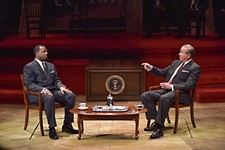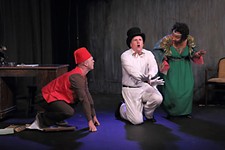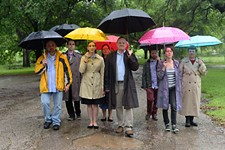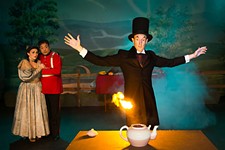The Children's Hour
Design takes center stage in Different Stages' revival of Lillian Hellman's drama
Reviewed by Adam Roberts, Fri., Jan. 13, 2012
The Children's Hour
City Theatre, 3823-D Airport, 524-2870www.citytheatreaustin.org
Through Jan. 28
Running Time: 2 hrs., 10 min.
As I entered the performance space at City Theatre on Saturday, I was reminded vividly of a conversation that unfolded during a seminar in theatrical design from my grad school tenure. Our class that afternoon had centered on the design features encountered by an audience before a performance has even begun, as well as the specific roles design nuances play in setting up an audience's anticipation of forthcoming events. After class that day, I never conceived of entering a performance venue set for a dramatic event in the same way again. Thank you, professor Isackes.
I was at City Theatre to take in Different Stages' production of The Children's Hour, Lillian Hellman's oft-banned drama of 1934. Thanks to the play's historical notoriety in the theatre, the plot is familiar to many. Young schoolteachers Martha Dobie and Karen Wright are falsely identified as lovers by one of the students at their boarding school in a series of events that makes the play feel like an eerie prequel to its younger sibling by 20 years, The Bad Seed. Conniving Mary Tilford knows what she's doing, just as bad seed Rhoda Penmark does, and in pursuit of attention will stop at nothing to see that her headmistresses' lives are shattered. In the Thirties, the play's content fated its prohibition from the stages of many major cities.
Now that nearly 80 years have passed since its debut, The Children's Hour is alive and well, having received a West End revival starring Keira Knightley and Elisabeth Moss just last year. Though Hellman's pages have yellowed a bit during the intervening years of social change, I was thrilled to find Ann Marie Gordon's fantastic set not a bit dusty as it played its preshow performance. With an art deco crispness suggested by a sleek, linear installation just downstage of the cyclorama, Gordon tells us the play's unwritten introduction.
It is the design of this production that takes center stage throughout and, indeed, powers much of the interpretative momentum. Justin Louis Morris' lighting design mingles subtly with the features of Gordon's set, and sound designer Jeff Miller's preshow playlist gives us important clues with regard to setting, bringing the outside world in – a significant and smart choice in a play focused on matters of public versus private. Emily Cawood's costumes tie together her colleagues' designs with rich texture and detailed attention to period style yet also suggest a freshness that makes them feel at home today.
Through the synergy of their collaborative work, the designers tell us that centuries will rendezvous in this production. We know from the outset that we're not about to engage with a museum piece about the Thirties. Instead, each one creatively asserts through silent storytelling, "What you are about to witness is relevant today: Don't think back – think now."











